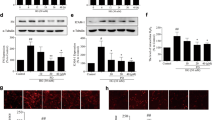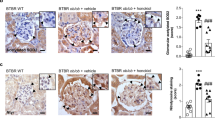Abstract
Diabetic nephropathy (DN) due to microvascular complication is a serious status characterized by continuously progressive until occurrence of the end stage of renal disease. It is attractive to investigate further mechanisms underlying the entity of DN and new drug discovery. We hypothesized that the entity of DN is inflammatory and is characterized by upregulated inflammatory/pro-inflammatory factors such as peroxisome proliferator-activated receptor alpha, NADPH oxidase, endoplasmic reticulum stress (ER stress), and endothelin receptor A (ETA) and downregulated connexin 43 (Cx43) in the kidney. Aminoguanidine is a special blocker to advanced glycation end products and argirein, a new compound contains a molecule of rhein linked to l-arginine by a hydrogen bond. Rhein possesses anti-inflammatory activity and has been chemically modified to produce a new compound diacerein launched in European market for treating osteoarthritis. Argirein with two active molecules rhein and l-arginine may be effective in suppressing the inflammatory cytokines contributing to the pathogenesis of DN. With a single injection of streptozotocin 65 mg/kg, ip in rats, early diabetic nephropathy was produced and revealed as an increased microalbuminuria, elevated creatinine and urea in serum, associated with upregulation of mRNA and protein of NADPH oxidase p22phox, p47phox, and p67phox and ETA, upregulated PKR-like eukaryotic initiation factor 2α kinase (PERK), and downregulated Cx43 in the renal tissue. Upregulation of PERK suggested that there is an ER stress involved in the diabetic kidney, along with an increase in inflammatory/pro-inflammatory factors indicating an entity of chronic inflammation. Abnormalities of biomarkers were blunted by either aminoguanidine or argirein significantly. The new compound argirein is potential in alleviating and retarding microvascular complications of diabetes such as DN in clinical settings.







Similar content being viewed by others
Abbreviations
- AGEs:
-
Advanced glycation end products
- AMG:
-
Aminoguanidine
- Cx40:
-
Connexin 40
- Cx43:
-
Connexin 43
- DM:
-
Diabetes mellitus
- DN:
-
Diabetic nephropathy
- ESRD:
-
End stage renal disease
- ER:
-
Endoplasmic reticulum
- ER stress:
-
Endoplasmic reticulum stress
- ET:
-
Endothelin-1
- ETA :
-
Endothelin receptor A
- ETB :
-
Endothelin receptor B
- Hcy:
-
Homocysteine
- NO:
-
Nitric oxide
- Nox1 and Nox 4:
-
Two catalytic subunits of NADPH oxidase
- P22:
-
NADPH oxidase subunit p22phox
- P47:
-
NADPH oxidase subunit p47phox
- P67:
-
NADPH oxidase subunit p67phox
- PERK:
-
PKR-like eukaryotic initiation factor 2α kinase
- PKA:
-
Protein kinase A
- PKCε:
-
Protein kinase C epsilon
- PPARα:
-
Peroxisome proliferator-activated receptor alpha
- ROS:
-
Reactive oxygen species
- UPR:
-
Unfolded protein response
References
Asaba K, Tojo A, Onozato ML, Goto A, Quinn MT, Fujita T, Wilcox CS (2005) Effects of NADPH oxidase inhibitor in diabetic nephropathy. Kidney Int 67:1890–1898
Brown WV (2008) Microvascular complications of diabetes mellitus: renal protection accompanies cardiovascular protection. Am J Cardiol 102:10L–13L
Chen R, Liang F, Morimoto S, Li Q, Moriya J, Yamakawa J, Takahashi T, Iwai K, Kanda T (2010) The effects of a PPARalpha agonist on myocardial damage in obese diabetic mice with heart failure. Int Heart J 51:199–206
Coronel I, Arellano-Mendoza MG, del Valle-Mondragon L, Vargas-Robles H, Castorena-Torres F, Romo E, Rios A, Escalante B (2010) L-Arginine and antioxidant diet supplementation partially restores nitric oxide-dependent regulation of phenylephrine renal vasoconstriction in diabetics rats. J Ren Nutr 20:158–168
Duckworth W, Abraira C, Moritz T, Reda D, Emanuele N, Reaven PD, Zieve FJ, Marks J, Davis SN, Hayward R, Warren SR, Goldman S, McCarren M, Vitek ME, Henderson WG, Huang GD, Investigators VADT (2009) Glucose control and vascular complications in veterans with type 2 diabetes. N Engl J Med 360:129–139
Etoh T, Inoguchi T, Kakimoto M, Sonoda N, Kobayashi K, Kuroda J, Sumimoto H, Nawata H (2003) Increased expression of NAD(P)H oxidase subunits, NOX4 and p22phox, in the kidney of streptozotocin-induced diabetic rats and its reversibility by interventive insulin treatment. Diabetologia 46:1428–1437
Foucher C, Brugère L, Ansquer JC (2010) Fenofibrate, homocysteine and renal function. Curr Vasc Pharmacol 8:589–603
Gao Q, Qin WS, Jia ZH, Zheng JM, Zeng CH, Li LS, Liu ZH (2010) Rhein improves renal lesion and ameliorates dyslipidemia in db/db mice with diabetic nephropathy. Planta Med 76:27–33
Gill PS, Wilcox CS (2006) NADPH oxidases in the kidney. Antioxid Redox Signal 8:1597–1607
Haidara MA, Yassin HZ, Zakula Z, Mikhailidis DP, Isenovic ER (2010) Diabetes and antioxidants: myth or reality? Curr Vasc Pharmacol 8:661–672
Hanner F, Sorensen CM, Holstein-Rathlou NH, Peti-Peterdi J (2010) Connexins and the kidney. Am J Physiol Regul Integr Comp Physiol 298(5):R1143–R1155
Herrmann A, Tozzo E, Funk J (2010) Semi-automated quantitative image analysis of podocyte desmin immunoreactivity as a sensitive marker for acute glomerular damage in the rat puromycin aminonucleoside nephrosis (PAN) model. Exp Toxicol Pathol. doi:10.1016/j.etp.2010.06.004
Hiukka A, Maranghi M, Matikainen N, Taskinen MR (2010) PPARalpha: an emerging therapeutic target in diabetic microvascular damage. Nat Rev Endocrinol 6:454–463
Hotamisligil GS (2010) Endoplasmic reticulum stress and the inflammatory basis of metabolic disease. Cell 140:900–917
Just A, Kurtz L, de Wit C, Wagner C, Kurtz A, Arendshorst WJ (2009) Connexin 40 mediates the tubuloglomerular feedback contribution to renal blood flow autoregulation. J Am Soc Nephrol 20:1577–1585
Kern TS (2007) Contributions of inflammatory processes to the development of the early stages of diabetic retinopathy. Exp Diabetes Res 2007:95103
Keynan S, Hirshberg B, Levin-Iaina N, Wexler ID, Dahan R, Reinhartz E, Ovadia H, Wollman Y, Chernihovskey T, Iaina A, Raz I (2000) Renal nitric oxide production during the early phase of experimental diabetes mellitus. Kidney Int 58:740–747
Lee TI, Kao YH, Chen YC, Pan NH, Chen YJ (2010) Oxidative stress and inflammation modulate peroxisome proliferator-activated receptors with regional discrepancy in diabetic heart. Eur J Clin Investig 40:692–699
Li N, Dai DZ, Dai Y (2008) CPU86017 and its isomers improve hypoxic pulmonary hypertension by attenuating increased ETA receptor expression and extracellular matrix accumulation. Naunyn-Schmiedebergs Arch Pharmacol 378:541–552
Li J, Wang JJ, Yu Q, Wang M, Zhang SX (2009) Endoplasmic reticulum stress is implicated in retinal inflammation and diabetic retinopathy. FEBS Lett 583:1521–1527
Liu HR, Tang XY, Dai DZ, Dai Y (2008) Ethanol extracts of Rehmannia complex (Di Huang) containing no Corni fructus improve early diabetic nephropathy by combining suppression on the ET-ROS axis with modulate hypoglycemic effect in rats. J Ethnopharmacol 118:466–472
Liu X, Li G, Zhu H, Huang L, Liu Y, Ma C, Qin C (2010) Beneficial effect of berberine on hepatic insulin resistance in diabetic hamsters possibly involves in SREBPs, LXRalpha and PPARalpha transcriptional programs. Endocr J 57:881–893
Lund AK, Peterson SL, Timmins GS, Walker MK (2005) Endothelin-1-mediated increase in reactive oxygen species and NADPH oxidase activity in hearts of aryl hydrocarbon receptor (AhR) null mice. Toxicol Sci 88(1):265–273
Luo L, Zheng YF, Dai Y, Dai DZ (2009) Hypercholesterolaemia induces early renal lesions characterized by upregulation of MMP-9 and iNOS and ET(A)R: alleviated bya dual endothelin receptor antagonist CPU0213 and simvastatin. J Pharm Pharmacol 61:775–780
Mannucci E, Monami M, Lamanna C, Gori F, Marchionni N (2009) Prevention of cardiovascular disease through glycemic control in type 2 diabetes: a meta-analysis of randomized clinical trials. Nutr Metab Cardiovasc Dis 19:604–612
Na T, Huang ZJ, Dai DZ, Zhang Y, Dai Y (2007) Abrupt changes in FKBP12.6 and SERCA2a expression contribute to sudden occurrence of ventricular fibrillation on reperfusion and are prevented by CPU86017. Acta Pharmacol Sin 28:773–782
Neuhofer W, Pittrow D (2006) Role of endothelin and endothelin receptor antagonists in renal disease. Eur J Clin Investig 36(Suppl 3):78–88
Noh JS, Kim HY, Park CH, Fujii H, Yokozawa T (2010) Hypolipidaemic and antioxidative effects of oligonol, a low-molecular-weight polyphenol derived from lychee fruit, on renal damage in type 2 diabetic mice. Br J Nutr 20:1–9
Okada T, Nakao T, Matsumoto H, Shino T, Nagaoka Y, Tomaru R, Wada T (2007) Association between markers of glycemic control, cardiovascular complications and survival in type 2 diabetic patients with end-stage renal disease. Intern Med 46:807–814
Ortmann J, Amann K, Brandes RP, Kretzler M, Münter K, Parekh N, Traupe T, Lange M, Lattmann T, Barton M (2004) Role of podocytes for reversal of glomerulosclerosis and proteinuria in the aging kidney after endothelin inhibition. Hypertension 44:974–981
Peng HJ, Dai DZ, Ji H, Dai Y (2010) The separate roles of endothelin receptors participate in remodeling of matrix metalloproteinase and connexin 43 of cardiac fibroblasts in maladaptive response to isoproterenol. Eur J Pharmacol 634:101–106
Ribeiro AB, Gavras H (2006) Angiotensin II antagonists: clinical experience in the treatment of hypertension, prevention of cardiovascular outcomes and renal protection in diabetic nephropathy and proteinuria. Arq Bras Endocrinol Metabol 50:327–333
Sheikh-Ali M, Sultan S, Alamir AR, Haas MJ, Mooradian AD (2010) Effects of antioxidants on glucose-induced oxidative stress and endoplasmic reticulum stress in endothelial cells. Diabetes Res Clin Pract 87:161–166
Strippoli GF, Craig M, Schena FP, Craig JC (2005) Antihypertensive agents for primary prevention of diabetic nephropathy. J Am Soc Nephrol 16:3081–3091
Sugimoto H, Grahovac G, Zeisberg M, Kalluri R (2007) Renal fibrosis and glomerulosclerosis in a new mouse model of diabetic nephropathy and its regression by bone morphogenic protein-7 and advanced glycation end product inhibitors. Diabetes 56:1825–1833
Tang XY, Liu Q, Dai DZ, Dai Y (2008) CPU0213, a novel endothelin receptor antagonist, suppresses the upregulation of matrix metalloproteinases and connexin 43 in hyperthyroid myocardium. Pharmacol Rep 60:524–531
Thallas-Bonke V, Thorpe SR, Coughlan MT, Fukami K, Yap FY, Sourris KC, Penfold SA, Bach LA, Cooper ME, Forbes JM (2008) Inhibition of NADPH oxidase prevents advanced glycation end product-mediated damage in diabetic nephropathy through a protein kinase C-alpha-dependent pathway. Diabetes 57:460–469
Tojo A, Asaba K, Onozato ML (2007) Suppressing renal NADPH oxidase to treat diabetic nephropathy. Expert Opin Ther Targets 11:1011–1018
Xu J, Li N, Dai DZ, Yu F, Dai Y (2008a) The endothelin receptor antagonist CPU0213 is more effective than aminoguanidine to attenuate isoproterenol-induced vascular abnormality by suppressing overexpression of NADPH oxidase, ETA, ETB, and MMP9 in the vasculature. J Cardiovasc Pharmacol 52:42–48
Xu M, Ji H, Dai DZ, Tang XY, Dai Y (2008b) Protective effect of the endothelin antagonist CPU0213 against isoprenaline-induced heart failure by suppressing abnormal expression of leptin, calcineurin and SERCA2a in rats. J Pharm Pharmacol 60:739–745
Xu M, Dai DZ, Dai Y (2009) Normalizing NADPH oxidase contributes to attenuating diabetic nephropathy by the dual endothelin receptor antagonist CPU0213 in rats. Am J Nephrol 29:252–256
Xu M, Dai DZ, Zhang Q, Cheng YS, Dai Y (2010) Upregulated NADPH oxidase contributes to diabetic testicular complication and is relieved by strontium fructose 1, 6-diphosphate. Exp Clin Endocrinol Diabetes 118:459–465
Zanatta CM, Gerchman F, Burttet L, Nabinger G, Jacques-Silva MC, Canani LH, Gross JL (2008) Endothelin-1 levels and albuminuria in patients with type 2 diabetes mellitus. Diabetes Res Clin Pract 80:299–304
Zheng JM, Zhu JM, Li LS, Liu ZH (2008) Rhein reverses the diabetic phenotype of mesangial cells over-expressing the glucose transporter (GLUT1) by inhibiting the hexosamine pathway. Br J Pharmacol 153:1456–1464
Zheng YF, Dai DZ, Dai Y (2010) NaHS ameliorates diabetic vascular injury by correcting depressed connexin 43 and 40 in the vasculature in streptozotocin-injected rats. J Pharm Pharmacol 62:615–621
Zhou Y, Luo P, Chang HH, Huang H, Yang T, Dong Z, Wang CY, Wang MH (2008) Colfibrate attenuates blood pressure and sodium retention in DOCA–salt hypertension. Kidney Int 74:1040–1048
Acknowledgments
This study was supported by the National Natural Science Foundation of China (No. 81070145) and by the National Key New Drug Innovation Program, Ministry of Science and Technology, China (No. 2009ZX09308).
Author information
Authors and Affiliations
Corresponding author
Additional information
C. Hu and C. X. Dong equally contribute to the paper.
Rights and permissions
About this article
Cite this article
Hu, C., Cong, X.D., Dai, DZ. et al. Argirein alleviates diabetic nephropathy through attenuating NADPH oxidase, Cx43, and PERK in renal tissue. Naunyn-Schmied Arch Pharmacol 383, 309–319 (2011). https://doi.org/10.1007/s00210-010-0593-7
Received:
Accepted:
Published:
Issue Date:
DOI: https://doi.org/10.1007/s00210-010-0593-7




